chrome door handles on unfinished pine door?
Hi There:
I am renovating the bathroom in my apartment, which has a taupe wall color (shenandoah taupe from Benjamin Moore) with everything else (ceiling, floor, fixtures) white and chrome. I was going to use polished chrome for door hardware. Yet as we couldn't decide on a stain color for the door we decided that it would look just as good in unfinished pine with a clear coat of polyurethane.
However, is chrome hardware on natural pine door faux pas? This is not a knotty pine door which would easily warrant a distressed, darkened hardware look; this is just a simple 6 panel solid pine door you get from home stores.
I have rarely seen combination of polished chrome on pine, and can't quite picture it in my head. The rest of the apartment is finished in white trims, grayish blue (gray cashmere by benjamin moore), standard yellow oak floor, accented in warm orange/red/pine colors and chrome/nickel.
Any advice are appreciated.
Comments (25)
User
14 years agolast modified: 9 years agoIs nickel hardware an option. It is softer looking than chrome, I think it would look better, if you need to stick with the cool metals.
magnaverde
14 years agolast modified: 9 years ago"Faux pas" is probably the a too-strong term for a combination of warehouse store pine door & shiny chrome, but like tuxedo pants & running shoes, I wouldn't do it. Then again, Madonna wore her bra on top of her sweater and got rich, so like I told someone the other day, there's always someone who'll like just about anything. Free will and all that.
So, rather than weigh the specific merits of polyurethaned pine combined with chrome, let's talk about one polyurethaned pine door in an apartment where everything else is finished in white trims, grayish blue (gray cashmere by benjamin moore), standard yellow oak floor, accented in warm orange/red/pine colors and chrome/nickel. My reaction would not be "OOH, I love the high/low contrast between the pine & the chrome" or even "Those finishes aren't working together" but "I guess they haven't had time to paint the bathroom door yet. Better not say anything."
Regards,
Magnaverde.Related Professionals
Crestview Interior Designers & Decorators · Mount Laurel Interior Designers & Decorators · Shorewood Interior Designers & Decorators · Van Wert Interior Designers & Decorators · Wilmington Furniture & Accessories · Naples Furniture & Accessories · Pleasant Grove Furniture & Accessories · Sahuarita Furniture & Accessories · Westport Furniture & Accessories · Palmetto Bay Furniture & Accessories · New Bedford Custom Artists · Jefferson Valley-Yorktown Lighting · Wasco Lighting · Brenham Window Treatments · New Baltimore Window Treatmentshoosiergirl
14 years agolast modified: 9 years agoJust so you can see pine and chrome together, I found this image of a pine coat rack with chrome hooks. I think Magnaverde is spot on. Did you already poly it? If not, you might want to make a mockup of your finishes before you do. Good luck with it!
Here is a link that might be useful:

ciac
Original Author14 years agolast modified: 9 years agohmm.. not trying to be dense, but do you mean that i should focus on staining the door instead? so unfinished pine is a questionable decision? yes we decided on that to save time, but i didn't think it'd be so horrible. oh well. i am open to corrections..
andee_gw
14 years agolast modified: 9 years agoWe need clarification about the other doors in your apartment: are they painted or are they all poly. pine? Why did you want to stain the pine and not paint it, if the other doors are painted?
sweeby
14 years agolast modified: 9 years agoI see clear-finished pine as 'casual country' in a bright, sunny and woodsy way -- a nice look.
But with taupe, blues and grays and painted white trim, I'm getting a mismatch with clear-coated pine. Unless your space is really 'Swedish County', the colors you already have seem more sophisticated, richer and more elegant than clear-coated pine.
In short - two totally different flavors that IMO, probably won't play well together.
magnaverde
14 years agolast modified: 9 years agoUnfinished pine & unstained (but polyurethaned) pine are two totally different things. Not long ago I went to a reception in a spectacular 192Os room in a zillion-dollar penthouse designed by the Chicago architect David Adler, and the living room was paneled in what looked like unfinished pine that had aged naturally to a beautiful honey tone. Of course, to achieve that 'natural' look, the wood had been planed, sanded, carved, bleached, stained, pickled & waxed, but the results were worth it. It was one of the most beautiful rooms I've ever been in. In the right hands, pine is like gold.
In one of my old places--a big old Victorian house--I stripped the doors of about 10 coats of paint and found beautiful, tight-grained old-growth pine underneath, which I finished with nothing but superfine steel wool & tinted paste wax--"Indian Sand" by Trewax, which, in my book, is a miracle product. When I finished, my doors were gorgeous, and people who think of pine doors as cheap & ugly must have only seen new pine doors. And to me, that's the problem with new pine: not that it's cheap, but that unstained, it still looks like raw lumber. That, of course, can be fixed--but only if the porous pine surface hasn't already been sealed with a coat of polyurethane.
At any rate, going by your original question, the real problem seemed to be not the collision of pine & chrome, but a single unstained pine door in a place where everything else had either been stained or painted. Now, maybe the way you phrased your question misled me into thinking that it was the only door like that, whereas, actually, you already had other doors in the same finish. In that case, the One-of-these-things-is not-like-the-others aspect of your pine bathroom door goes away. But if not, the mismatch aspect is still an issue. Because while a single accent piece or accent color can be effective in a space where everything else matches, that unique thing--whatever it is--generally needs to be a step up from everything else, either in quality, materials, or workmanship, rather than a step down. That just looks makeshift.
That's why, although a diamond choker on a black t-shirt is a classic--if cliched--bit of high-low dressing because the quality of the jewelry elevates its background, doing it the other way around usually falls flat. The cachet of an elegant designer dress is seldom helped by a necklace from a gumball machine.
ciac
Original Author14 years agolast modified: 9 years agoi live in a studio apartment, and the only other full door is the front door, painted in white with polished brass hardware. the closet door is going to be a pine bifold (not installed yet) finished the same way as the bathroom door. These three doors don't occupy the same visual space: there's a corridor which leads to the front door, where the closet door also resides at the side of the corridor. The most visible door from the living space (colored gray cashmere) will be the bathroom door.
when I had a contractor, he suggested a golden oak stain color, which I thought wasn't too far off from a natural pine finish, just more yellow. I also thought of using water based stains/finish for speed and low VOC. However, not able to decide on a color, and being a total novice in this, I figure a coat or two of clear water based polycrylic is probably the easiest way for me to go. I imagined the natural wood color would not clash terribly with the rest of the blue-tone color, with furnitures also in golden wood tone.
I was honestly surprised to see that the unstained door would be the problem. I am not sure what would be a finish that is a step-up from the rest of the room, or whether if I can even achieve it without much experience. I thought staining/polying would be better/more interesting than painting the door white, but now does it look like a better idea than to leave it in clear poly?
Also what kind of treatments should I do to the door? I only have seen video tutorials about staining doors and painting over the web, and it seems many stained doors look just as rough and unfinished as raw lumber. I have also seen beautiful doors, but as you can see, I don't know what makes the difference, hence the "easy way out" approach.
If you would enlighten me with a better approach, I'd love to learn. Thanks.
paint_chips
14 years agolast modified: 9 years agoI would do white to match your trim. It would work with every element you described.
ciac
Original Author14 years agolast modified: 9 years agoThanks Magnaverde for the informative writing.
I agree with you that small spaces shouldn't cramp the styling department. In fact I regard my small studio as a training ground of tastes and decorating before I move to a bigger place. It seems every little detail matters even more in a smaller space, and thankfully it'll also be small enough to be manageable during renovations. However, I am also of the group who need to achieve their styles with a very limited budget.
I've learned a lot from web forums like this one, haven't worked with a designer in the past. Apparently there is still yet a lot to learn.
I understood the color and attention, and how one should try to leave the less important camouflaged--in this case paint the door white with the trims. However, as you correctly speculated, I was influenced by the camp where any "natural wood grain" would count as more beautiful than plain colors, and that hiding any solid wood grain is a shame. In fact it is a belief that I am having a hard time relinquishing.
I did originally plan to paint the door white, like many of the less luxurious apartments from the 20s seemed to have. I was trying to be architecturally correct, and tried to pick out a single panel/5 panel door, but eventually I thought of them as too much expense/work, and a goal that's nearly impossible to achieve after multiple (rather careless) renovations by past owners.

Here is the 6 panel pine door I got from a home warehouse store, at a fraction (less than 1/3) of the price of a fir single panel I was originally going to get. I figure if I screw up it won't be a $300 door ruined. I tried to pick one with a better looking grain, though it's all pretty similar. This picture is a good mock-up of the colors in the room: the gray cashmere on the wall, the pine door color, and golden oak floors.Is there any other stylistically acceptable alternative to painting the door white? Will other stain colors do? Yes, I am still clinging to the idea of staining the door, as I loved some of the stained doors in larger homes, but I will also let go of it quickly when it is deemed unacceptable. Like you said, pine doors are probably never meant to be stained.
I replaced the original hollow core door with a solid wood one, due to the heft and overall feel; but then I also wondered if i can extract even more from this investment, hence the idea of staining.
The layout of the apartment is a bit odd, in that the bathroom door is almost too prominently displayed in the room (imagine an rectangular living space with a door at one of the corners). That's part of the reason why I almost gave up the possibility of making the door invisible, but wondered if I can make it more beautiful than a slab of white. Now I learned, however, that apparently staining a pine door doesn't make it beautiful either huh?
Many thanks for your thoughts, and especially if you have more. It's a lot for me to think about, while I finish the trims and threshold.
Ciac
p.s. this may be a little off topic: while painting pine trims, I noticed the grain of the wood becomes raised. I also noticed many homes with stained doors that have a very rough surface finish. Is it just a matter of door quality, or painting/staining/treatment technique? How do I prevent the door from becoming rough when stained/painted? Tks.
2ajsmama
14 years agolast modified: 9 years agoCan you post a picture of the room looking at the door? Then we can help you decide whether you should paint it (them) or stain. I happen to be in the "natural wood" camp, though I love all painted (white) trim with nice profiles and the right walls colors when i see it in other people's houses. But I loved the stained pine trim in my last house so we specified it in the house we built (though I didn't realize it was going to be so cheap - builder talked me out of buying my own and installing it one room at a time, said it would be cheaper and easier (16 ft lengths) to let him cut it to fit and "tack it loosely" in place for me to finish later).
"Condition" the pine with a thinned coat of shellac or poly before you stain it, to even out the color. Here is a door I did with Minwax prestain conditioner, followed by gel stain in Honey Maple, then shellac as a sanding sealer (don't sand stain without any finish on top of it - the prestain conditioner and gel stain don't raise the grain as much as a penetrating oil- or water-based stains but it still raises it), followed by Minwax Wipeon poly. The Wipeon takes a lot more coats than a brushed on poly but is foolproof. You will need to sand before you put the conditoner on (though I wouldn't sand to finer than 320 - most people do 150-220 but I found my doors were so soft they were showing scratches and I needed to go finer) and in between each coat (I used 400 and then ended with 600 for a glassy finish). Be sure to use a sanding block so you don't round off the details of the panels.
Painting would be easier (fewer coats, even counting primer, and less sanding). Paint it the same color as the wall.
Here is a link that might be useful: Finishing technique
magnaverde
14 years agolast modified: 9 years agoOK, working backwards...
That rough surface of a lot of painted & stained doors these days is either a sign of laziness or cost-cutting on the part of a professional, or of an amateur who's seen so many rough doors he thinks they're supposed to be like that. They're not. Some woods finish beautifully with minimal effort, but pine is not one of them.
Those dark & light areas in your door's grain are two different textures, evidence of the tree's growth cycle. The dark is hard & smooth and doesn't take stain well, and the the light is so soft you can dent it with your fingernail and it soaks up stain like a sponge, which leads to really unpredictable results when using stain. Yes, that can be avoided by using a thinned-down sealer before the stain, but thats a skill set that most amaters don't have, so they skip it, with the above results. Either that, or knowing all of that (but not wanting to bother with the sealer route) they just skip the stain completely, slap on a coat of polyurethane and call it a day, which essentially creates the look of shiny new lumber. That's why, when dealing with new pine, I always recommend paint.
Now, water based paints will raise the grain of softwoods, and a lot of people don't bother to sand it smooth & give it a second coat--or maybe a third--and so end up with a rough painted door instead of a rough stained door. Either way, it looks (and feels) like hell. You don't have to spend a fortune on a hardwood door to get a nice finish, but money saved in materials generally means you need to spend more time in finishing them. There's cheap, fast & good. You can have any two, but you can't have all three.
Anyway, so that's the issue with staining pine or using water-base paints on pine: loud, erratic grain & lots of sanding to be done.That's why, if I have new pine trim to deal with, I use oil base paints. Because of the solvents & the smell, a lot of places don't stock it anymore (or only offer it in limited colors) but most paint stores can get it for you. Done correctly--that is, with lots of sanding--oil-based paint gives a beautiful, smooth finish that can't be achieved any other way. In my old place I used high gloss white, and because of its slow drying time, it had plenty of time to level out all the brushstrokes so that it was almost as smooth & glassy as the white enamel on my vintage stove. Of course, the smell was a pain, but I had a whole house worth of trim to do, and since you only have a door or two, it shouldn't be that bad. Some of the nices paints out there are farrow & balls oil paints. They're not cheap, but for one door you won't need much and application is a dream.
You can get high gloss in water based paints too, these days, but the fast drying time isn't as forgiving as with slower drying paints, so don't try to go back & touch up runs or thin spots or you'll have a mess. If I were going the water-based route--and Behr makes a nice super-shiny enamel which dries really fast--I'd experiment with my painting technique on the inside of the closet door, where if you screw up, no one will notice. Like they say, practice makes perfect. M.
2ajsmama
14 years agolast modified: 9 years agoIf you don't like the shiny new look (which my doors have even though I used satin poly) you can "age" pine with stains and glazes but it's even more work. Fine Homebuilding had an article (I believe it was a cover article) earlier this year on how-to. Seal the door, dye it not stain), finish, glaze, finish.
Can you post a picture of your room? Paint might be best, and if you can return the doors you might as well go with Masonite - solid wood is prone to warping, esp. in a bathroom. If you keep the door you have, make sure to finish/paint *all* edges as well as the paneled front/back.
trancegemini_wa
14 years agolast modified: 9 years agomagnaverde brings up a very important point about staining pine. It doesnt take up the stain evenly and you will get areas that will take up the stain better than others. I have stained pine as an inexpensive alternative to using the hard to come by original wood used in my house but I have stained it very dark and within an inch of its life. lol. It won't fool anyone who looks close enough though.
I think you should go ahead and paint it white, it's more straight forward than staining and varnishing and will be a good way to get some painting experience to start out with and while some woods have beautiful grains and colours to them and the price tag to match, painting over pine doesnt have the same guilt factor IMO.
annzgw
14 years agolast modified: 9 years agoOk.........I'll admit I haven't read every post, but I thought I'd give you a visual.
All my interior doors are clear fir with a sealer. Don't know what type sealer since the builder was out of the picture when I purchased the house. My front door is lightly stained mahogany and the french doors & side panels off the LR are all painted white.My floors are white oak and not as dark IRL as they appear in the photos. Just thought seeing this may help your decision or whether you like it or not!
Oh, the difference in grain does show up lighter than other areas, but I find it give the doors character.ciac
Original Author14 years agolast modified: 9 years agoAjsmama: The door pics look really nice, with a smooth look. I learned from mostly Minwax literature and some forums that I'll need pre-stain treatment to solve the grain/absorption problem with woods like pine. Then I was just going to stain, and with a final coat of poly.
I wasn't sure where sanding would come into the picture, probably just sanding off the dusts/specs that got trapped in the poly. I am not even sure what I can do with the raised grain with a water based paint/stain. The raised grain on the trim (after being painted with glossy latex paint) was just about impossible to sand down. I suppose it's not terrible being trims, but for doors that may just make enough difference to matter. I am using a 150 grit paper.
I was thinking of using small foam rollers to apply the poly, if not the stain, for an even finish. However, that's just a thought in theory: in testing on sample drywall/wood blocks, smoothest finish with anything water based paint/finish could be achieved with those high density foam rollers, much more easily than brushes.
Of course, these are the plans from someone who has no experience and learned from very scattered materials. I see here that there's a 4th step before coating with poly, to "use shellac as a sanding sealer". I'm not sure how that works, how to apply (I imagine coating and sanding, assuming shellac is a softer material than poly to sand down for a smoother finish?), or what exactly shellac is. I'm just that far off the curve here. :P
Magnaverde: I just learned how oil based may achieve a superior finish. I asked around in the store and nobody could tell me the difference between oil and water based other than that water dries faster and doesn't smell. That made it an easy choice, as it is getting pretty cold here and opening window to vent VOC will be tough. Given that, I'm wondering now how difficult will it be to sand down the grain if I use water based stain/paint, to achieve a similar result to oil based paint/varnish/stain? Also if done properly (with pre-stain treament and all), is staining the pine with those grains acceptable, and in what color/finish? I suppose "naked door" with poly is nobody's cup of tea here. :)
I'm not sure if a sketch of the room's dimensions will help visualizing the door better than a picture of one corner. Here it is:

As you can see the apt has a very odd layout that cannot be salvaged easily. The door in question is the one to the top, next to the window/mock sofa. Most of the furniture are in maple/natural/pine color, as they were modular and simply carried over from the apartment rental days (new furniture may be in order). I haven't sketched up the trims though, but they are 4" base trims with 3.5" door casing, the largest I could get without going to the lumber yard for some much fancier versions. The trims and casing are painted in benjamin moore's "superwhite" in glossy finish. The front door (right hand side) at the end of the corridor is finished in white. The closet (center of the apt) has a bifold pine door that will be finished the same as the bathroom door. I'd appreciate any ideas/opinions with the door finish, again.
I'm thankful of all the help here. This is so much more than I imagined I'd get in return to my question, which was originally thought to be as simple as a door knob finish. :) The question with the door had always been a bit nebulous to me, and it's just now began to clear up. Thanks guys.
2ajsmama
14 years agolast modified: 9 years agoStart with 100 or 150 but a unfinished pine door is *not* sold ready to finish - you will have to take off little shavings/splinters from the edges of the panels and sand out milling marks (which if you look closely run vertically down the door, including across the horizontal stiles). *Then* when you have it smooth (but not not glass-smooth - you want the stain to have some "bite") you can condition it - don't wait an hour or whatever Minwax says to stain after conditioning, wait 24 hrs or so esp. if using penetrating (non-gel) stain. Then stain (make sure to get the excess out of the corners!), let dry, then seal with dewaxed shellac - I used Zinnsser Sealcoat. Shellac dries quickly so you'll be able to sand it (it's *harder*, more brittle than poly so you can sand it very smooth w/o leaving fine scratches) in an hour or so and apply your first coat of poly. Follow the directions on the poly (depends on how thick you apply it) for drying and recoating time, but poly doesn't dissolve itself to chemically bond between coats, you have to scuff sand to give it a mechanical bond. I found my pine doors were so soft (and Wipeon poly is so thin) that 220 grit was too coarse for b/t coats, used 320 and then 400 and put 6 coats on the door I didn't shellac. The shellac helped cut down the number of coats of poly on the 2nd door - I think I only used 3 or 4. Follow the instructions in the link and I think you'll be happy. But it's definitely more work than painting.
If you paint, I'd sand the door probably starting with 100 (maybe 150 if it looks pretty good), up to 220. Then shellac, sand again, and paint. The shellac will keep the paint from soaking in and lifting the grain - you'd have to see if you needed to sand b/t coats. I thought that painting the door the same color as the wall would make it blend in more, but with white trim maybe not.
Do you have actual photos of the apt?
2ajsmama
14 years agolast modified: 9 years agoOh BTW, if you use a "natural" stain (or no stain at all, that's fine) and it's too light, you can always do what they call a "glaze" over the finish to darken it. Gel stains work really well as glazes. I also like gel stains on pine b/c they don't penetrate and lift the grain, they actually seem to seal it a bit more for a smoother finish. I used gel stain on all the baseboard (except the bathroom) and casings in my house (and the doors I showed you). I did the bathroom side of the bathroom door with just conditioner (sealer) and poly b/c I wanted it lighter, and it was harder to get smooth than the hall side of the same door (closeup above) or the linen closet door (full length photo).
There are different types of pine too, and they take stain differently. Even though my doors and trim are both radiata pine, I found the baseboards to be harder and took stain more evenly, sanded smooth with just 220, but the doors were softer and scratched, had to use higher grits. Of course they're at eye level and get more light too so it's more noticeable.
ciac
Original Author14 years agolast modified: 9 years agoHey ajsmama:
So is it safe to say that Shellac is similar to poly as a final protective finish over stain? A quick search shows shellac as a natural resin finish, probably used in place of poly before the latter's availability. Is it possible to poly and sand it down to a smooth finish and skipping the shellac step (yeah I'm looking for ways to speed things up), seeing how the two "may" be interchangeable? (correct me if I'm wrong).
Thanks for all those door finishing tips. It sounds like a great idea to seal with shellac before painting to avoid raised grain. However I am also curious if that'll affect paint adhesion if I shellac first? Also is letting pre-stain seal sit for 24 hours for the purpose of penetration, drying, or both?
Here's a picture of the door/window in the disaster that's my apartment (shades will go and be replaced with drapes. the contractor conveniently didn't put up window casing.. but just try to ignore all that ugliness)

2ajsmama
14 years agolast modified: 9 years agoOK, can't see the floor in that pic but looking at wall and trim colors I'm saying paint - and I think even paint the door the same color as the wall. You'd have to ask on Paint forum about shellac causing problems with paint adhesion - I don't think it would. Shellac and poly are *not* interchangeable though. Shellac would help get a smooth finish and it sticks to anything, anything sticks to it (the dewaxed version). I can't imagine what you'd have to do to get paint to stick to poly (strip it off? don't think sanding would even work) - I think you'd have a mess on your hands, if you already had something poly'd you could try it but don't make things harder for yourself when you're starting from scratch. Poly doesn't even really want to stick to *itself*, so requires scuff sanding.
I found link on Woodworking forum a while back about letting the prestain (basically thinned finish, you could even use thinned-out Sealcoat though I had Minwax conditioner in red can I needed to use up, had bought it before I bought shellac) cure longer to cut the blotchniess - and it does work better than following the Minwax instructions! Link was to Popular Woodworking but it's not working now. But if you're painting, just a coat of shellac to seal is fine. Check over at Paint forum about sanding b/t shellac and paint and in b/t coats of paint - I really haven't tried painting previously unpainted wood.
2ajsmama
14 years agolast modified: 9 years agoThe original 2004 article isn't available on Popular Woodworking any more, but here's an explanation. If you use Sealcoat as a conditioner, make sure to thin it out with denatured alcohol, don't use it right out of the can, or you won't have any choice but to use a gel stain (as more of a glaze) since the shellac won't let anything penetrate.
Here is a link that might be useful: Wood Conditioning
2ajsmama
14 years agolast modified: 9 years agoNow the same author is saying just use gel stain to prevent blotching - though I was too chicken to try it (might try on inside of closet door).
Sorry if this is TMI (overload)!
Here is a link that might be useful: Battling Blotching
ciac
Original Author14 years agolast modified: 9 years agojust want to make sure: if I paint the door with water based semi-gloss paint, does it have to be any special types, or is it just the same as those which goes on the walls?
Besides sanding down the raised grains after first coat (what grit should I use? The raised grain under a coat of paint was pretty hard to sand when I painted the trims), is there anything else that I need to do for a smooth final finish? I am planning on using the foam roller again, but not sure how to get the grooves in the panels area done without much streaking. The paint dries very quickly, and within minutes it could not be re-touched. That'll be a challenge. Spray paint?
Thanks.
annzgw
14 years agolast modified: 9 years agoI suggest you check the Paint Forum for more details, but I believe you should use an oil based primer to prevent raising the grain. You should only need to do a very light sanding for any rough areas.
What paint are you using that dries so quickly? There are additives that can be mixed in the paint that will make working with it a little easier. Ask your paint dealer which is best, but I've had luck with Floetrol.You should be able to use a roller on all the flat surfaces but purchase a quality, tapered paint brush (2-2 1/2") for all the detail areas.
Here is a link that might be useful: Floetrol

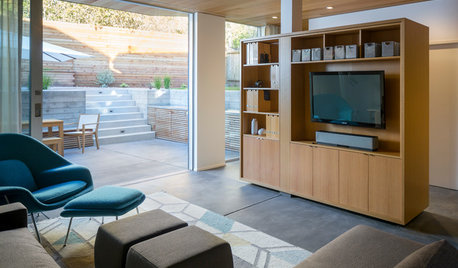
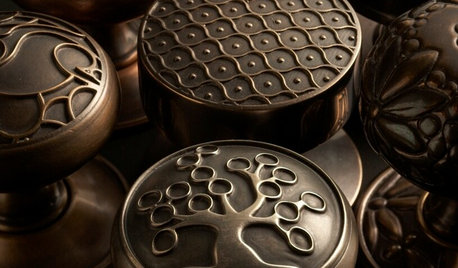
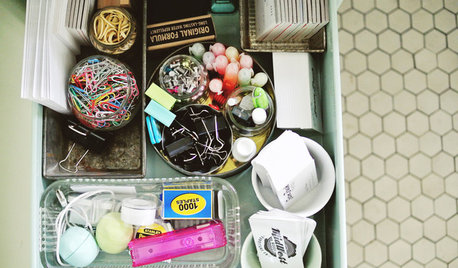
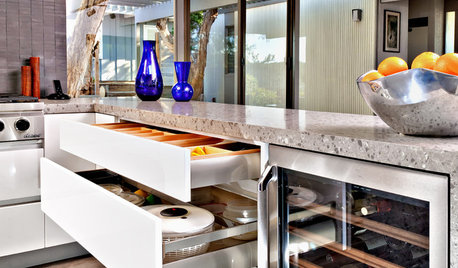
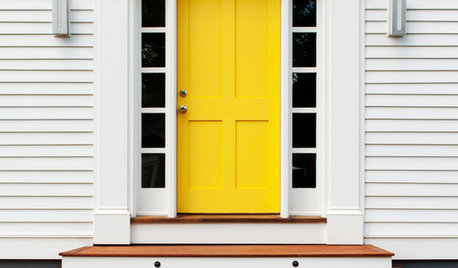
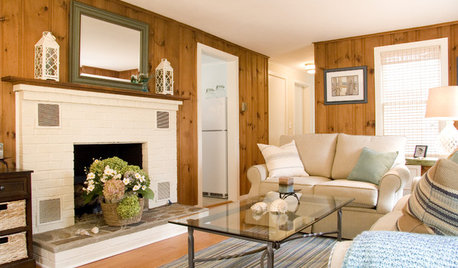
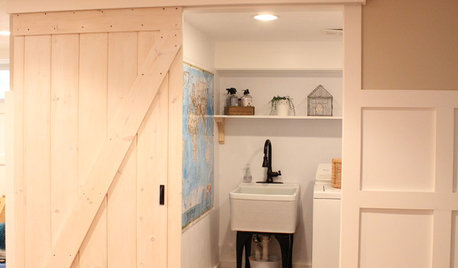







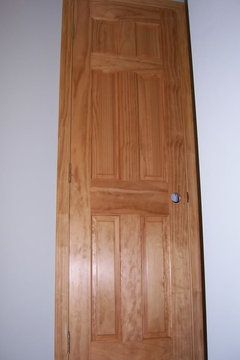
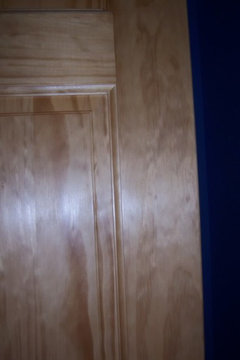
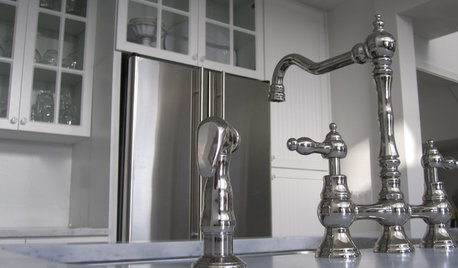
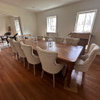


magnaverde